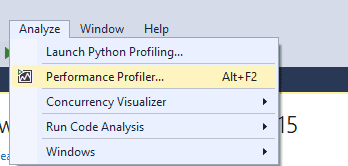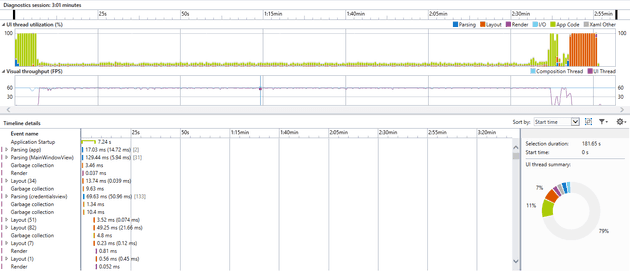WPF is an interesting (and currently still active framework. How long that will continue depends, IMHO, largely on how well MS can bring UWP XAML to a state where people are happy to switch.
I recently investigated a performance problem in one of our WPF screens. After running a few analysis tools, including Prefix (which I’m finding increasingly my first port of call for this kind of thing), I came to the conclusion that the performance problem was with the screen itself.
Performance Profiler
You can reach this via:
Analyse -> Performance Profiler
You can actually run this against a compiled exe, a store app, or even a website. For my purposes, I ran it against the screen that I’d identified as being slow:
The bar graph above clearly marks out the points at which the app suddenly spikes, and the legends tells me that it’s caused by the layout. With this information, you can highlight relevant area:
Once I did this, I could instantly see that a very large number of controls were being created:
So, the problem here was that the client was going to the service and bringing back a huge volume of data, and as soon as this was bound to the screen, WPF was attempting to render the layout for thousands of controls immediately.
The Solution
So, the solution to this issue is to virtualise the ItemsControl. Whilst the standard items control will attempt the render the layout for every possible control bound to the underlying data, virtualising it allows to it only render those that are actually displayed on the screen. Here’s how you might achieve that:
<ItemsControl Grid.Row="1" ItemsSource="{Binding Path=MyObject.Data}"
Margin="10" BorderBrush="Black" BorderThickness="2"
VirtualizingPanel.VirtualizationMode="Recycling"
VirtualizingPanel.IsVirtualizing="True"
ScrollViewer.CanContentScroll="True">
<ItemsControl.Template>
<ControlTemplate>
<ScrollViewer HorizontalScrollBarVisibility="Disabled" VerticalScrollBarVisibility="Auto">
<ItemsPresenter/>
</ScrollViewer>
</ControlTemplate>
</ItemsControl.Template>
<ItemsControl.ItemsPanel>
<ItemsPanelTemplate>
<VirtualizingStackPanel Orientation="Vertical" Margin="5" IsItemsHost="True" />
</ItemsPanelTemplate>
</ItemsControl.ItemsPanel>
Re-running the screen with the analyser reveals that we have now alleviated the spike in activity:
Summary
Obviously, there is a trade-off here; if you’re dealing with a screen that will be used extensively and change very infrequently, then you might decide it’s better to have the upfront hit (as the work still needs to be done). However, if you’re loading so much data that you’re in this situation, I would have thought it very unlikely that the end-user is ever going to want to actually see it all!
It’s also worth acknowledging here that this solution doesn’t actually speed anything up, just defers it. I’m not saying that’s a good or bad thing, but it is definitely a thing.
References
http://stackoverflow.com/questions/2783845/virtualizing-an-itemscontrol





